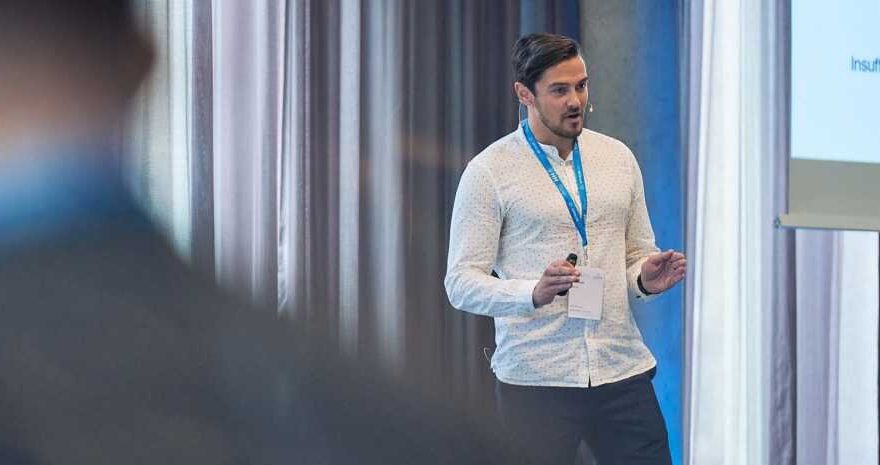
Whether for squats or sit-ups, the software created by the start-up VAY alerts exercisers about incorrect movements via a smartphone screen. Now the ETH spin-off has been acquired by connected fitness equipment manufacturer Nautilus.
Joel Roos has a knack for coming up with inventive solutions to problems. Here’s an example from ten years ago, when he was an ambitious young volleyball player: “We were supposed to practice receiving, but a lot of serves didn’t even make it over the net. The training was inefficient,” he says. So he built a volleyball machine that sped the balls over the net in such a way as to maximize the challenge for the players on the receiving team. Whether or not it was thanks to the machine, Roos and his teammates were soon promoted to the highest division in Switzerland.
Roos sporting ambition was also one of the factors that led to his creation of VAY. The start-up has developed software that can use a simple camera to record movements in real-time and provide feedback. This means it can be used as a digital coach during fitness or physiotherapy exercises. The realization that something like this was needed came to Roos a few years ago, when as a professional volleyball player he would spend many long hours in the weight room. “I’d see a lot of people training there moving poorly and doing the exercises incorrectly.” He came up with the idea of an app that gives users real-time feedback to make their workouts healthier and more effective.
Software gives live feedback
At VAY’s offices in Zurich’s Enge quarter, one of the rooms is decked out with fitness mats, dumbbells, and other exercise equipment. Roos flips open a laptop and launches an app. To demonstrate what the software can do, he stands a couple of meters in front of the computer and does a few squats. On the video image that can be seen on the screen, green lines trace his movements. Positions and angles are compared to the optimal execution in the background, and after each of Roos’s repetitions the computer tells him: “Great job!” Then he intentionally performs the exercise inaccurately, bending his knees less. “Go deeper,” the computer now says.
The technology behind the virtual coach works with a simple camera, making it smartphone compatible. While VAY’s isn’t the only software that can analyze human movements, it certainly is one of the best. According to Roos, the software runs at up to 100 frames per second. Another unique selling point for VAY is how it draws on both artificial and human intelligence: the algorithms feedback is based on the latest findings in movement science. Experienced sport coaches define the exercises, thereby determining the optimal movements.
In total, VAY has already recorded around 200 exercises this way, mainly for people working out at home using their own body weight. Next on the agenda is strength training with dumbbells. According to Roos, the technology is also suitable for physiotherapy or yoga. “One of our big advantages is that we can feed new exercises into the system very quickly,” he says; a rate of around twenty exercises per movement scientist per month is definitely achievable.
Attempt to market a fitness app
VAY originally launched its own app for fitness enthusiasts. It included 30 exercises presented in different languages by several sport coaches, some of them well known. While the download numbers were impressive, there is fierce competition in the fitness app market. For example, Nike also has sport coaches demonstrate fitness exercises on mobile phones. The Nike app may not have the same sophisticated technology, but it does have lots of nice features—and a lot of marketing capital behind it.
As a result, VAY decided to discontinue its app and focus instead on further developing the technology. This new approach attracted powerful partners, including leading global fitness groups, and the B2B model soon got investors’ pulses racing, too. For example, health insurer CSS invested in VAY to build a digital physio coach. The start-up also won 150,000 Swiss francs in pre-seed capital from the Venture Kick funding initiative.
Interest in the ETH spin-off was ultimately so strong that just two years after it was founded, VAY already had several acquisition offers on the table. Finally, this autumn, the company sealed the deal on an acquisition by fitness equipment manufacturer Nautilus.
The challenge of personalisation
Now, 15 employees are working to incorporate VAY’s technology into Nautilus applications and devices. Roos explains that one of the next goals is to optimize the software for strength training (with dumbbells). In the longer term, VAY is set to become a kind of innovation lab for Nautilus with a focus on developing new technologies. The location in Zurich and the proximity to basic research at ETH Zurich (where Roos himself graduated with a Master’s degree in Robotics) suits VAY well. “We’re hoping that we can stimulate the fitness tech industry a little bit in this country,” Roos says.
One of the biggest challenges for the future will be to personalize the software. Currently, the exercises are optimized for the average user. However, the company also wants to reach people whose mobility is limited due to, say, knee or shoulder problems. “The long-term goal is for the software to recognize the pattern behind incorrect movements and suggest solutions,” Roos says. For example, if someone always puts more of their weight on one leg, the software should detect this imbalance and automatically suggest corrective exercises.
Source: Read Full Article
